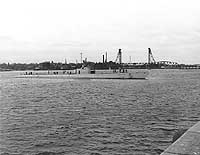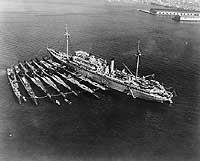
USS Cachalot, first of a class of two 1130-ton submarines, was built at the Portsmouth Navy Yard, opposite Portsmouth, New Hampshire. Commissioned at the beginning of December 1933, she was employed on trials and in other test work before moving to San Diego, California, in October 1934. From then until June 1937 Cachalot mainly operated along the West Coast and in Hawaiian waters. She then returned to the East Coast for experimental torpedo firing and training duties. In June 1939, after taking part in fleet maneuvers and more training, the submarine went back to the Pacific and was sent on to Pearl Harbor, Hawaii, her base for the next three years.
Cachalot was undergoing overhaul at Pearl Harbor when the Japanese attacked there on 7 December 1941, thus beginning World War II in the Pacific. She conducted her first war patrol, an intelligence-gathering cruise into the enemy-held Marshall and Caroline Islands, in January-March 1942. An overhaul followed to correct mechanical difficulties that were a constant problem in submarines of her vintage. In early June Cachalot was employed on picket duty during the Battle of Midway, after which she carried out her second war patrol, this time off the Japanese home islands. Alaskan waters were the scene of the submarine's third combat cruise, beginning in September 1942. Like her previous patrols, this produced no sinkings of enemy ships.
At the end of her north Pacific patrol Cachalot, whose mechanical unreliability was too serious for further combat service, was transferred to New London, Connecticut. She spent the rest of World War II assigned to the Submarine School as a training submarine. USS Cachalot was decommissioned in mid-October 1945 and sold for scrapping in January 1947.
This page features all the views we have related to USS Cachalot (SS-170).
| If you want higher resolution reproductions than the digital images presented here, see: "How to Obtain Photographic Reproductions." |
Click on the small photograph to prompt a larger view of the same image.
|
Photo #: 19-N-14689 USS Cachalot (SS-170) Leaving the Portsmouth Navy Yard, Kittery, Maine, for a 5000-mile endurance test, 7 March 1934. Photograph from the Bureau of Ships Collection in the U.S. National Archives. Online Image: 103KB; 740 x 600 pixels Reproductions of this image may also be available through the National Archives photographic reproduction system. |
 |
|
Photo #: 80-G-63334 USS Holland (AS-3) With seven submarines alongside, in San Diego harbor, California, 24 December 1934. The submarines are (from left to right): Official U.S. Navy Photograph, now in the collections of the National Archives. Online Image: 123KB; 740 x 620 pixels Reproductions of this image may also be available through the National Archives photographic reproduction system. |
 |
|
Photo #: NH 82789 USS Holland (AS-3) In San Diego harbor, California, circa 1935. Submarines alongside are (from outboard to inboard): Closest ship in the nest of destroyers at far right is USS Yarnall (DD-143). Donation of Mrs. Kelly Green, 1974. U.S. Naval Historical Center Photograph. Online Image: 94KB; 740 x 500 pixels |
 |
|
Photo #: NH 68481 USS Holland (AS-3) Panoramic photograph of the ship moored at Bouy 19, San Diego harbor, California, in 1940, with eleven submarines alongside. Submarines are (from left to right): Salmon (SS-182); Seal (SS-183); Stingray (SS-186); Perch (SS-176); Pollack (SS-180); Cachalot (SS-170); Cuttlefish (SS-171); Skipjack (SS-184); Sturgeon (SS-187); Snapper (SS-185) and Sargo (SS-188). SS-182 through SS-187 were members of Submarine Division 15, commanded by R.W. Christie. USS Richmond (CL-9), flagship of the Submarine Force, is in the right distance. Courtesy of the U.S. Naval Institute. James C. Fahey Collection. U.S. Naval Historical Center Photograph. Online Image: 53KB; 900 x 310 pixels |
 |
Other views concerning USS Cachalot (SS-170):
In addition to the images presented above, the National Archives appears to hold other views of USS Cachalot (SS-170). The following list features some of these images:
The images listed below are NOT in
the Naval Historical Center's collections.
DO NOT try to obtain them using the procedures described in our
page "How to Obtain Photographic Reproductions".
|
USS Cachalot (SS-170) underway at sea, 23 August 1938. Starboard broadside (somewhat toward the bow) aerial view. USS Cachalot (SS-170) underway on course 090 while off southwestern Long Island (position 41 15'N, 71 50'W), 31 May 1944. Photographed from a blimp of squadron ZP-11. Port quarter (relatively toward the side) high aerial view.
Reproductions of these images should be available through the National Archives photographic reproduction system for pictures not held by the Naval Historical Center. The images listed in this box are NOT in the Naval Historical Center's collections. DO NOT try to obtain them using the procedures described in our page "How to Obtain Photographic Reproductions". |
| If you want higher resolution reproductions than the digital images presented here, see: "How to Obtain Photographic Reproductions." |
Page made 11 November 2003